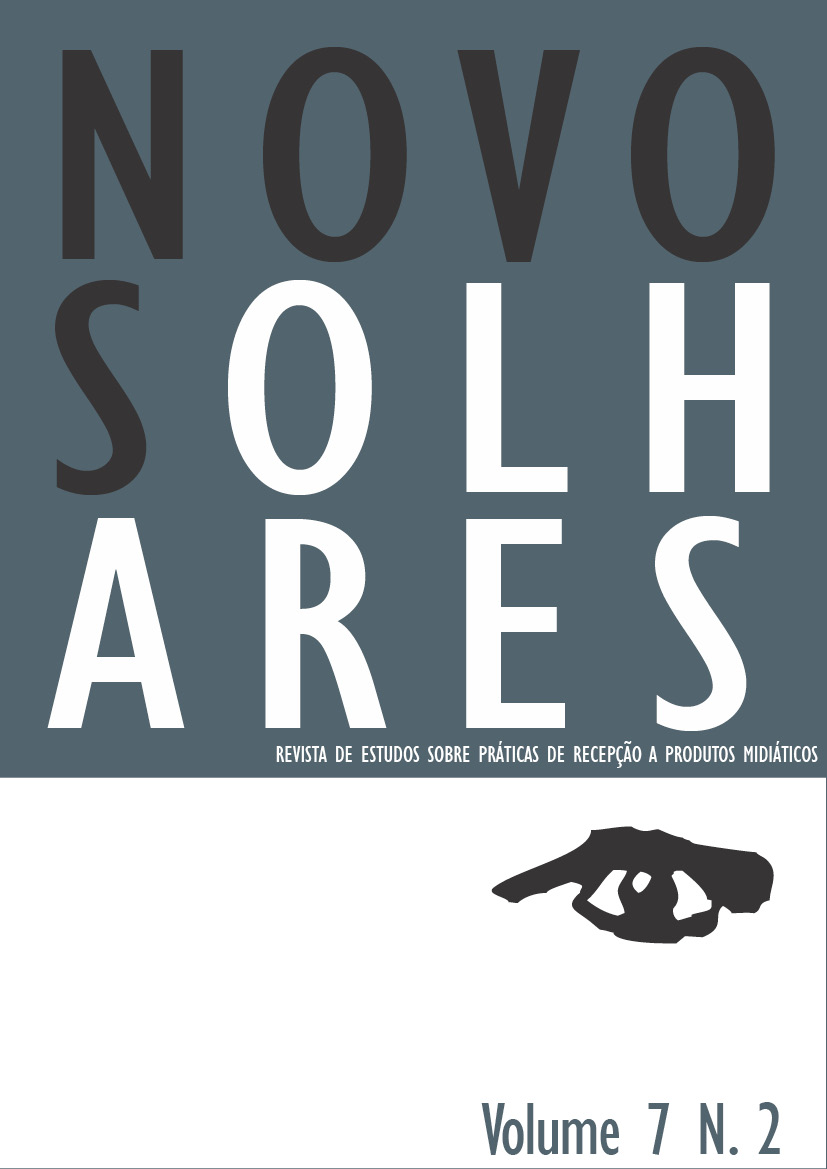“The Industry is Cultural”
John T Caldwell’s Contributions for Research on Communications
DOI:
https://doi.org/10.11606/issn.2238-7714.no.2018.149048Keywords:
John T. Caldwell, Media industries, Media texts, Communications, TelevisionAbstract
We aimed at understanding the methodological and theoretical approach of the filmmaker and television researcher John T. Caldwell in addressing the recent transformations of cultural and intellectual practices in the American media industry. We discuss the author's proposal of an “integrated analysis” of Communication phenomena from a multidisciplinary perspective, comprising political economy, sociology, anthropology, aesthetics, narrative, and cultural studies. We explore his discussions of classical concepts, such as “media industries” and “media texts,” as well as his problematization of the interface between scientific research and cultural industries. The author suggests more rigor on the part of Communication researchers to avoid that their works are co-opted by media industries, increasingly preoccupied in commoditizing the theorizations of their industrial practices.
Downloads
References
BOURDIEU, P. As regras da arte. São Paulo: Companhia das Letras, 2002.
CALDWELL, J. T. Televisuality: style, crisis and authority in American television. New Brunswick: Rutgers University, 1995.
______. Industrial Geography Lessons: Socio-professional rituals and the borderlands of production culture. In: COULDRY, N.; MCCARTHY, A. (Org.). MediaSpace: place, scale and culture in a media age. Londres: Routledge, 2003. p. 163-189.
______. Welcome to the viral future of cinema (television). Cinema Journal, Austin, v. 45, n. 1, p. 90-97, Autumn 2005. Disponível em: <https://bit.ly/2C5RJVZ>. Acesso em: 15 out. 2017.
______. Production culture: industrial reflexivity and critical practice in film and television. Durham: Duke University, 2008.
______. Screen studies and industrial “theorizing”. Screen. Oxford, v. 50, n. 1, p. 167-179, Spring 2009a.
______. Hive-sourcing is the new out-sourcing: studying old (industrial) labor habits in new (consumer) labor clothes. Cinema Journal, Austin, v. 49, n. 1, p. 160-167, Fall 2009b. Disponível em: <https://bit.ly/2NwJXX3>. Acesso em: 14 out. 2017.
______. Breaking ranks: backdoor workforces, messy workflows and craft disaggregation. Popular Commnication, Londres, v. 8, n. 3, p. 221-226, 2010. Disponível em: <https://bit.ly/2Od2tJj>. Acesso em: 17 out. 2017.
______. Para-industry: researching Hollywood’s blackwaters. Cinema Journal, Austin, v. 52, n. 3, p. 157-165, Spring 2013. Disponível em: <https://bit.ly/2yp4uY5>. Acesso em: 12 out. 2017.
______. Para-Industry, Shadow Academy. Cultural Studies. Londres, v. 28, n. 4, p. 720-740, 2014. Disponível em: <https://bit.ly/2ytZFNc>. Acesso em: 13 out. 2017.
CARDOSO, C. P. Outras falas: feminismos na perspectiva de mulheres negras brasileiras. 2012. Tese (Doutorado em Estudos Interdisciplinares sobre Mulheres, Gênero e Feminismo) – Universidade Federal da Bahia, Salvador, 2012.
CAVES, R. E. Creative industries: contracts between art and commerce. Cambridge: Harvard University Press, 2002.
COULDRY, N. Media rituals: a critical approach. Londres: Routledge, 2002.
DENA, C. Transmedia practice: theorising the practice of expressing a fictional world across distinct media and environments. Tese (Doutorado em Culturas Digitais) –University of Sidney, Sidney, 2009.
FREHSE, F. Clifford Geertz. O saber local: novos ensaios em antropologia interpretativa. Revista de Antropologia, São Paulo, v. 41, n. 2, p. 235-243, 1998. Disponível em: <https://bit.ly/2Ppaw2v>. Acesso em: 22 out. 2017.
GOMES, I. Gênero televisivo como categoria cultural: um lugar no centro do mapa das mediações de Jesús Martín-Barbero. In: Revista Famecos, Porto Alegre, v. 18, n. 1, p. 111-130, jan./abr. 2011.
HESMONDHLAGH, D. The Menace of Instrumentalism in Media Industries Research and Education. Media Industries Journal, Ann Arbor, v. 1, n. 1, p. 69-74, 2014. Disponível em: <https://bit.ly/2E8mhsF>. Acesso em: 13 out. 2017.
HESMONDHALGH, D.; BAKER, S. Creative labour: media work in three cultural industries. Londres: Routledge, 2011.
JENKINS, H. A cultura da convergência. 2. ed. São Paulo: Aleph, 2009.
KRESS, G.; LEEUWEN, T. Multimodal discourse: the modes and media of contemporary communication. Londres: Bloomsbury Academics, 2001.
LIFE in a Day. Box Office Mojo, 10 set. 2018. Disponível em: <https://bit.ly/2OfVSy2>. Acesso em: 10 out. 2018.
LOTZ, A. D. The television will be revolutionized. Nova York: NYU Press, 2007.
MARTÍN-BARBERO, J. Dos meios às mediações: comunicação, cultura e hegemonia. 2. ed. Rio de Janeiro: UFRJ, 2003.
MAYER, V. Bringing the “social” back in: studies of production cultures and social theory. E-compós, Brasília, v. 12, n. 3, set./dez. 2009. Disponível em: <https://bit.ly/2AiNMvQ>. Acesso em: 17 out. 2018.
MITTELL, J. Genre and television: from cop shows to cartoons in American culture. Londres, Routledge, 2004.
NEWCOMB, H. À procura de fronteiras no campo dos estudos de mídia. Comunicação & Sociedade, São Bernardo do Campo, a. 23, n. 36, p. 73-87, 2 semestre 2001.
SHADOW Academy. Wookieepedia, the Star Wars Wiki, [S.l.], 22 maio 2006. Disponível em: <https://bit.ly/2NBGjeC>. Acesso em: 10 out. 2018.
VONDERAU, P. Industry proximity. Media Industries Journal, Ann Arbor, v. 1, n. 1, p. 69-74, 2014. Disponível em: <https://bit.ly/2OgsVle>. Acesso em: 13 out. 2017.
WACQUANT, L. Esclarecer o habitus. Educação & Linguagem, Porto, v. 10, n. 16, p. 63-71, 2007. Disponível em: <https://bit.ly/2CsLziN>. Acesso em: 21 out. 2017.
Downloads
Published
Issue
Section
License
Proposta de Aviso de Direito Autoral Creative Commons
1. Proposta de Política para Periódicos de Acesso Livre
Autores que publicam nesta revista concordam com os seguintes termos:
- Autores mantém os direitos autorais e concedem à revista o direito de primeira publicação, com o trabalho simultaneamente licenciado sob a Licença Creative Commons Attribution CC Attribution-NonCommercial-NoDerivatives 4.0, que permite o compartilhamento do trabalho com reconhecimento da autoria e publicação inicial nesta revista.
- Autores têm autorização para assumir contratos adicionais separadamente, para distribuição não-exclusiva da versão do trabalho publicada nesta revista (ex.: publicar em repositório institucional ou como capítulo de livro), com reconhecimento de autoria e publicação inicial nesta revista.
- Autores têm permissão e são estimulados a publicar e distribuir seu trabalho online (ex.: em repositórios institucionais ou na sua página pessoal) a qualquer ponto antes ou durante o processo editorial, já que isso pode gerar alterações produtivas, bem como aumentar o impacto e a citação do trabalho publicado.



